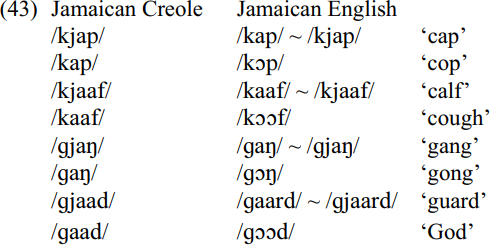


 Grammar
Grammar
 Tenses
Tenses
 Present
Present
 Past
Past
 Future
Future
 Parts Of Speech
Parts Of Speech
 Nouns
Nouns
 Verbs
Verbs
 Adverbs
Adverbs
 Adjectives
Adjectives
 Pronouns
Pronouns
 Pre Position
Pre Position
 Preposition by function
Preposition by function 
 Preposition by construction
Preposition by construction
 Conjunctions
Conjunctions
 Interjections
Interjections
 Grammar Rules
Grammar Rules
 Linguistics
Linguistics
 Semantics
Semantics
 Pragmatics
Pragmatics
 Reading Comprehension
Reading Comprehension|
Read More
Date: 2024-02-15
Date: 2024-04-22
Date: 2024-03-16
|
The distribution of palatals and labial velars in JamE is clearly influenced by the JamC-to-JamE conversion processes which many speakers carry out. One problem converting JamC lexical inputs into an acceptable JamE realization is the fact that JamC /a/ may be realized as JamE /a/ or /ɔ/ , depending on the lexical item. There is no way, taking the JamC phonological form, /pat/, of knowing whether the JamE form should be /pat/ ‘pat’ or /pɔt/ ‘pot’. However, when JamC /a/ is part of a syllable with a palatal or labial velar stop onset, these invariably predict the correct JamE output.
Let us first take the palatals. In JamE, /kj/ and /gj/, phonetically palatal stops, [c] and [Ɉ] , have a distribution in which they vary with each other before /a/ and /aa/ but not in other environments. Thus, the item ‘cap’ has two realizations in JamE, /kap/ and /kjap/, whereas the items ‘coo’ /kuu/ and ‘queue’, /kjuu/ show a /k/ versus /kj/ phonemic contrast. The JamE /kap/ ~ /kjap/ ‘cap’ variation reflects the fact that /kj/ is part of the lexical specification of cognate items in JamC, serving to distinguish it from /kap/ ‘cop’. With the JamE pronunciation of ‘cop’ being /kɔp/, the use of /kj/ in /kjap/ has no distinctive functional value. It, however, represents a carry-over from JamC which, we argue, provides the lexical input that lies at the base of JamE phonetic output.
In the examples below, the item with /kj/ or /gj/ in the JamC item has /kj/ or /gj/ as variant forms in JamE, followed by /a/. The items which have /k/ or /g/ in the JamC item, require an invariant /k/ or /g/ in the JamE cognate and /ɔ/ as the following vowel. The weight of the phonemic distinction, transferred from the consonant in JamC to the vowel in JamE, is still expressed redundantly in the form of a residual /kj/ variant in JamE.

A very similar kind of situation applies with the labial velars, where again the presence of a semi-vowel linked feature predicts whether JamC /a/ is realized as JamE /a/ or /ɔ/ . The difference is that there are environments in which palatals occur categorically, i.e. before vowels other than /a/ and /aa/. By contrast, labial velars only occur variably in JamE, before the diphthong /ɔi/. Its JamC reflex, /ai/, is the only environment in which they may occur in JamC. In JamE, it represents a redundant feature, the labialization of /b/ in the environment of an /ai/ which has /ɔi/ as its JamE reflex. This represents independent support for the notion that the conversion process is from a JamC underlying input to JamE and not the other way around. Otherwise, we would have no way of understanding how a variable occurrence of /w/ in JamE can be converted into a categorical appearance of this form in the JamC cognates.

|
|
|
|
علامات بسيطة في جسدك قد تنذر بمرض "قاتل"
|
|
|
|
|
|
|
أول صور ثلاثية الأبعاد للغدة الزعترية البشرية
|
|
|
|
|
|
|
مدرسة دار العلم.. صرح علميّ متميز في كربلاء لنشر علوم أهل البيت (عليهم السلام)
|
|
|